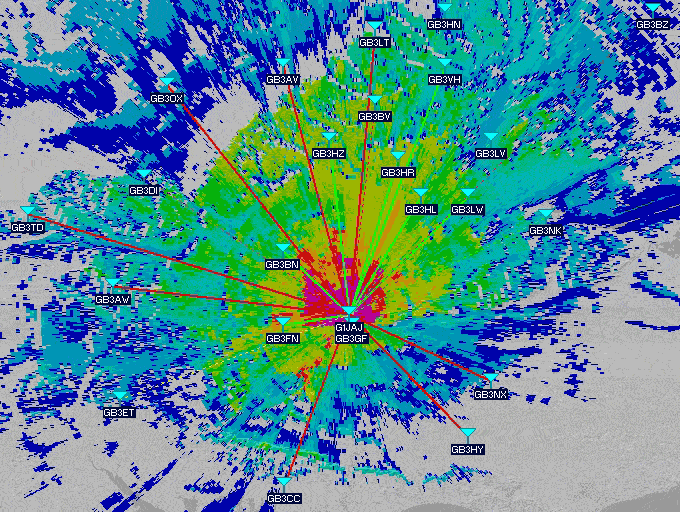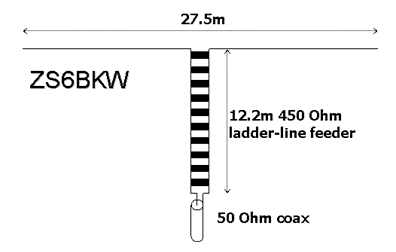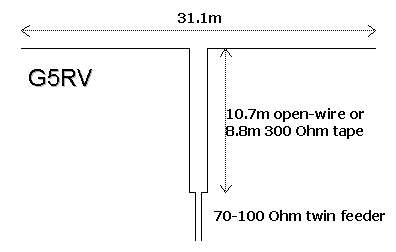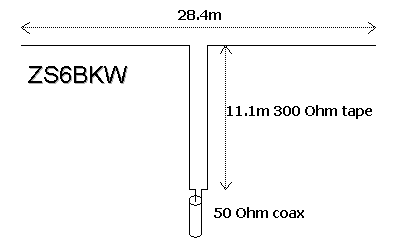Tuesday 17 April, 2007, 15:58 - Amateur Radio
Posted by Administrator
Posted by Administrator
 These days, a lot of radio planning (broadcasting and cellular for example) relies heavily on the ability to use computers to predict coverage from a site. So Wireless Waffle thought it would prove an interesting exercise to do some coverage predictions from a known radio station and compare them with actual reception. It's probably worth adding that using a single receive antenna in a fixed location for comparison isn't necessarily fair - reflections could mean that there are strong nulls in a particular direction, though with the antenna mounted nice and high and above most nearby obstacles these effects are minimised.
These days, a lot of radio planning (broadcasting and cellular for example) relies heavily on the ability to use computers to predict coverage from a site. So Wireless Waffle thought it would prove an interesting exercise to do some coverage predictions from a known radio station and compare them with actual reception. It's probably worth adding that using a single receive antenna in a fixed location for comparison isn't necessarily fair - reflections could mean that there are strong nulls in a particular direction, though with the antenna mounted nice and high and above most nearby obstacles these effects are minimised.The prediction tool used is RadioMobile, which is a freeware tool designed for radio amateurs and does pretty good VHF and UHF predictions as well as path profiles which can be used to hazard a guess at microwave links too. The 70 centimetre amateur band was used as the test case and the signals from various neighbouring repeaters as the benchmark. Most repeaters have decently sited antennas at a reasonable height and free of local obstructions and so should make for a reasonably accurate prediction.
First off, a scan around the 70cm (433 MHz) band on a day when propagation is flat was conducted, to see which repeaters could be heard and what strength they were. Here's the list (channels not listed are ones on which nothing was heard):
RB0 GB3BN S9+ (Bracknell)
RB1 GB3BV S3 (Hemel Hempstead)
RB2 GB3LV S1 (Ealing)
RB3 GB3HL S9+ (Hillingdon)
RB6 GB3LW S3 (Central London)
RB7 GB3HZ S9+ (Amersham)
RB12 GB3GF S9+ (Guildford)
RB13 GB3VH S3 (Welwyn Garden City)
RB14 GB3HR S9+ (Harrow)
RB15 GB3FN S9+ (Farnham)
 So the question is, could a computer prediction reproduce this set of results? The parameters of the station plus those of all the nearby repeaters (including those that are nearby but which weren't received) were entered into RadioMobile and a plot produced. The results are shown on the right (click to see the full size version).
So the question is, could a computer prediction reproduce this set of results? The parameters of the station plus those of all the nearby repeaters (including those that are nearby but which weren't received) were entered into RadioMobile and a plot produced. The results are shown on the right (click to see the full size version).The easiest way to see what the results show is to look at the colour of the line between the amateur station used and the various repeaters. A solid red line indicates that the prediction shows there to be no possibility of a signal getting through; yellow indicates that reception would be on the fringes of possibility and green indicates that all should be OK. A dotted line shows that the prediction is borderline between two possible outcomes. So here's what the prediction says (ignoring all those which are purely red and thus should be inaudible):
RB0 GB3BN Green
RB1 GB3BV Dotted Red
RB2 GB3LV Dotted Green
RB3 GB3HL Green
RB4 GB3NK Dotted Green
RB6 GB3LW Green
RB6 GB3DI Dotted Red
RB7 GB3Hz Green
RB11 GB3HN Dotted Green
RB12 GB3GF Green
RB13 GB3VH Green
RB13 GB3ET Dotted Yellow
RB14 GB3HR Green
RB15 GB3FN Green
A number of predictions have been highlighted in bold as these are at variance with what was borne out in practice. It seems there are 4 other repeaters which should be audible that aren't. Also, GB3BV is shown as very marginal on the prediction yet is a reasonably good signal. However, the prediction has correctly identified approximately the correct likelihood of reception for 9 of the original 10 repeaters being received.
So are predictions any good? From the results shown here, they're not bad, however the relatively simple predictions produced by RadioMobile are probably insufficiently complex to take account of other factors that play a major role in radio propagation such as clutter from trees and buildings. Nonetheless, not a bad result and an interesting illustration of the power of computers.
add comment
( 1494 views )
| permalink
| 



 ( 3 / 12081 )
( 3 / 12081 )




 ( 3 / 12081 )
( 3 / 12081 )
Friday 9 February, 2007, 16:06 - Amateur Radio
So having whet your appetite with details of the ZS6BKW multi-band antenna, I've finally finished my own installation of the antenna and will share my findings with you. The good thing about this particular multi-band antenna is that it covers the majority of the HF amateur bands that I'm interested in, particularly 80m, 40m, 17m and 12m, as well as 20m. 10m coverage (and 80m for that matter) is a bit poor.The original design shows two wires of 14.2 metres fed with 11.1m of 300 Ohm twin-feeder. However having scouted around the internet, I discovered that there is a revised version using 450 Ohm ladder-line feeder (which seems to be as easily if not more easily available than the 300 Ohm stuff). It has the main advantage that it's marginally smaller which, given the rather small size of my back garden meant that it should just squeeze into the available space.

One element of the original design that seems odd is the suggestion that no balun is needed at connection between the twin-feeder and the coax cable. Fundamentally, twin-feeder is a balanced system and coax is an unbalanced system and any radio (or audio) engineer will tell you that connecting one to the other is a recipe for disaster. In the case of radio systems, the upshot is usually that RF radiates from the outer of the coax increasing the potential for RFI and picking up more interference from neighbouring electrical devices (computers etc).
I managed to get a pole on the back of the house, the top of which is about 30ft (10m) above ground level and stretched the necessary 13.75m of copper wire (uncoated) from the pole to the two corners of the back garden which just fits. The whole installation is in the form of a sloping inverted-V with each end probably no more than about 12ft (4m) above ground level. The 450 Ohm ladder line is fastened along the soffit board, runs down the back of a plastic drain pipe and then along a wall until it meets the 50 Ohm coax - not straight or vertical or perpendicular to the antenna in any way. At this point, the coax (RG-58U which is sufficient as the run is so short) is wound 8 times through a iron powder ferrite to form a choke balun. A run of less than 10m of coax then terminates in the shack.
Like all experimenters, I cut both the wire (13.8m) and the ladder line (12.3m) slightly too long to allow for tweaking later. My first assembly resonated on 6.86, 13.76, 17.64 and 24.15 MHz (and less well on 3.4 and 28.44 MHz too) - on average about 4% low in frequency. The original ZS6BKW article does mention that installed in an inverted-V configuration, resonances would be a little low.
After reducing the length of the ladder line to the design figure of 12.2m and tweaking the length of the wires, ending up at 13.5m, the antenna now resonates beautifully on 7.1, 14.11, 18.06 and 24.8 MHz. On each of these frequencies, the SWR is below 1.3:1 indicating a pretty good match. There are also dips in SWR at 3.55 MHz (SWR 5:1) and 29.02 MHz (2:1) and, usefully, at 50.84 MHz (3:1) meaning I can also use the antenna on 6m too with a bit of a tweak of a tuning unit.
I haven't had the antenna in place long enough to determine its DX potential yet, but stations over 5000km away are readily audible. Having searched the net for articles on this antenna, I found very few so I thought documenting my experience might help others. Let me know how you get on.
Wednesday 10 January, 2007, 13:37 - Amateur Radio
I make no real apology for the blatant plagiarism here. Following my comments back in September 2006 on All Band Antennas for Skinflints, I've been trying to find the original article relating to the ZS6BKW antenna as I fancied making one. Nowhere could I find the article on-line but I did manage to get a friend to scan in the article from the original Radio ZS publication in 1985. I'll document in a future blog my experiences of getting this fascinating idea of an antenna built and to work as well as providing details of the different variants which I've found scattered around the net, but for now, here's the text of the original article:
The July 1958 edition of the RSGB Bulletin contained an article by Louis Varney G5RV on a novel multiband dipole which did not require traps. Figure 1 (below) shows the antenna, later to become known universally as the ‘G5RV’.
Like so many good ideas it is so simple. It works as follows: On 20m the flat-top is three halfwaves long. Its feedpoint impedance is therefore low and because the open-wire line is one half-wave length on that band it merely transfers that low impedance to its other end and there presents a reasonable match to the ‘Twin’ feeder on the rig. On 40m the feedpoint impedance is very high (and inductive) because the antenna is now three quarters of a wavelength, but the transmission line transformer is now one quarter-wavelength and so functions as a quarter-wave transformer. Hence the high value of the load impedance, Z(L), is transformed into a much lower value, Z(IN), by the well-known relationship for the quarter-wave transformer:
Z(IN)=Z(O)²/Z(L)
Where Z(O) is the characteristic impedance of the open-wire line, typically 300-600 Ohms. It is rather like an automatic ATU hanging off the antenna! On 15m and 10m the antenna/feedline combination were again said to combine to present reasonable impedances to the twin-feeder, which was all that a valve power amplifier with link or pi-coupling ever requires. The tubes of that era coped far better with mismatches than do the solid-state devices of today!
On reflection, it soon became apparent that one should be able to improve on the performance of this antenna by using a computer to optimise the length of the flat-top and matching transformer such that the impedance presented at the transmitter end of the line more closely matches the 50 Ohms, plus or minus a few, that our modern finals will tolerate.
To do this we need to know the feedpoint impedance of a centre-fed dipole antenna as we change its length and as we change the frequency. This can be calculated but it by no means an easy task and a far simpler approach (and one that is probably more reliable) is to use the data which is available in the professional literature. Professor R W P King at Harvard University had fortunately provided us with this information in tabular form. To use it requires only that it be stored in a ‘look-up’ table in the computer. Given the frequency and the length of the antenna, we then have its impedance.
The next step was to consider the role of the transmission line transformer. How long should it really be and is one value of Z(O) better than another? Without going into any detail here suffice it to say that Louis Varney’s statement, way back in 1958, that Z(O) was not too critical is in fact not far off the mark. It has been shown that there is a broad peak of Z(O) values from about 275 Ohms to 400 Ohms, which will work adequately. This means that either homemade open-wire line or commercial 300 Ohm tale could be used. Do choose the best quality 300 Ohm tape though because that sold for FM-band folded dipoles doesn’t really weather at all well.
To determine the length of the matching section we use the standard transmission line equation which gives us Z(IN) if we know Z(L) and Z(O), the frequency and the length of that line. By re-arranging the equation we can find the length at any given frequency and Z(O) once we’ve used the ‘look up’ table to find Z(L). Of course Z(IN) is fixed by the required standing wave ratio on the 50 Ohm cable to the rig. Usually this VSWR may not be more than 2:1, and is always specified by the transceiver manufacturer.
Armed with this information writing the computer program is a fairly conventional procedure and will not be described here. Ideally a single antenna should operate on all the HF bands from 160 through to 10m. That is a tall order though so we would probably settle for a compromise of say five of the nine bands (including the three new ones.) Having chosen that number we then instruct the computer to change the flat-top length, the length of the matching section and Z(O) until it finds that combination of the three parameters which yield better than 2:1 VSWR on at least five bands. Clearly this involved an iterative or ‘going around the loop’ procedure and can take a fair amount of computer time, but the results are worth the effort.
In Figure 2 (above) are the details of the improved, computer-designed, G5RV. You will notice that the flat-top is shorter than Varney’s and that the matching section is longer. A velocity factor of 0.85 was used for the 300 Ohm tape. Particularly important is the fact that this new antenna is designed for use with 50 Ohm cable and not the 70-100 Ohm twin of 1958. No balun is specified simply because neither the theory nor considerable experimentation justified the inclusion of one. Simply interconnect the 300 Ohm tape and the 50 Ohm coax, taking the normal precautions to keep moisture out.
Both in theory, from the computer predictions, and in practise, when erected horizontally at a height of 13m, the antenna provides an acceptable match on the 7, 14, 18, 24 and 28 MHz bands. The original G5RV was tested by way of comparison (both with the computer and in the field) and found to be far less effective. Only the 14 and 24 MHz bands produced standing wave ratios of less than 2:1 when fed with 75 Ohm cable, as designed.
The new antenna was also tested in the very popular inverted-V configuration and the results showed, not unexpectedly, that the frequency on each band at which the best match occurred were all shifted somewhat lower, but the same general characteristics as discussed above for the horizontal configuration still applied. Likewise, changing the height above ground from 7 to 13m did not markedly change the situation either. It must be realised, of course, that the old dictum ‘the higher the better’ always applies.
Modern technology has been put to work to optimise an antenna conceived empirically nearly 30 years ago and the results should give the old G5RV a new lease of life.
Brian Austin, ZS6BKW
More on this interesting aerial to follow soon...
Wednesday 8 November, 2006, 15:29 - Amateur Radio
 When I'm at home, my receiver is usually switched on monitoring one frequency or another, commonly 145.500 or the local 70 cm repeater. Yesterday I was doing the latter and it soon became apparent that there was some active tropogation around. In addition to my local repeater, other amateur repeaters from typically 300km distant were fading in and out with regularity. What I noticed, however, was that the audio for all these distant repeaters (and, mysteriously, the local ones too) was accompanied by a rather annoying crackle.
When I'm at home, my receiver is usually switched on monitoring one frequency or another, commonly 145.500 or the local 70 cm repeater. Yesterday I was doing the latter and it soon became apparent that there was some active tropogation around. In addition to my local repeater, other amateur repeaters from typically 300km distant were fading in and out with regularity. What I noticed, however, was that the audio for all these distant repeaters (and, mysteriously, the local ones too) was accompanied by a rather annoying crackle.My first thought was that the coax cable feeding the antenna must have a dry joint in it somewhere and the gentle wind blowing it back and forth was causing an intermittent connection. But I checked reception of repeaters on 2 metres and these were clear of the crackling noise which indicated that the effect was real, and was being received right across the 430-440 MHz band.
The next port of call was the various items of household equipment that could cause such relatively focussed wide-band noise; thermostats, fluorescent lights, computers, vacuum cleaners and similar devices being the typical culprits. But wandering around the house with a hand-held UHF receiver, it soon became apparent that none of these were the problem, nor could the crackle now be heard at all on the local repeater, though it was still there on more distant stations.
Then I remembered the BMEWS radar at Fylingdales near Scarborough and Whitby on the North Yorkshire Moors. This operates from 420 to 450 MHz and is renowned for producing interference resembling a crackling sound right across this frequency range. Obviously the tropogation was carrying the BMEWS signal the 350 km across the UK to my receiver.
Having now heard the kind of noise that this early warning radar produces, it amazes me that radio amateurs anywhere in Yorkshire or Durham can use the 70 cm band at all, but apparently they do! But this isn't the only noisy noise that annoys users of this band.
 Recommendation 70-03 largely prohibits the use of voice or audio signals in this sub-band, but that doesn't stop (cheap) equipment being produced that is capable of doing just that. And if cheap equipment is available, someone will buy it. Monitoring 433.925 MHz in my area yields what sounds like a wirless audio link being used to relay television sound from one room to another, as well as occasional walkie-talkie like conversations. But who is going to stop this equipment being used illegally like this? Ofcom? They can't even keep obvious spectrum miscreants such as pirate radio operators down, so they're unlikely to be bothered about people who are using voice in a non-voice band.
Recommendation 70-03 largely prohibits the use of voice or audio signals in this sub-band, but that doesn't stop (cheap) equipment being produced that is capable of doing just that. And if cheap equipment is available, someone will buy it. Monitoring 433.925 MHz in my area yields what sounds like a wirless audio link being used to relay television sound from one room to another, as well as occasional walkie-talkie like conversations. But who is going to stop this equipment being used illegally like this? Ofcom? They can't even keep obvious spectrum miscreants such as pirate radio operators down, so they're unlikely to be bothered about people who are using voice in a non-voice band.So can anything be done to recover the band for radio amateurs? Well the old adage 'use it or lose it' has never been more applicable. If the band were full of transmissions, the ERO would never have considered it for such low-power devices. But it's not too late. A good 20 Watt transmitter on 433.925 MHz should wipe-out key-fobs, freezer failure detectors and other mindless devices over a good few hundred or more metre radius. So next time you want to chat with a local amateur, why not go simplex on 70 cm on, say, 433.925 MHz just for the hell of it?! Antisocial? Me? It's legal. It's simple and it's worthwhile. See you on 70 cm then...




